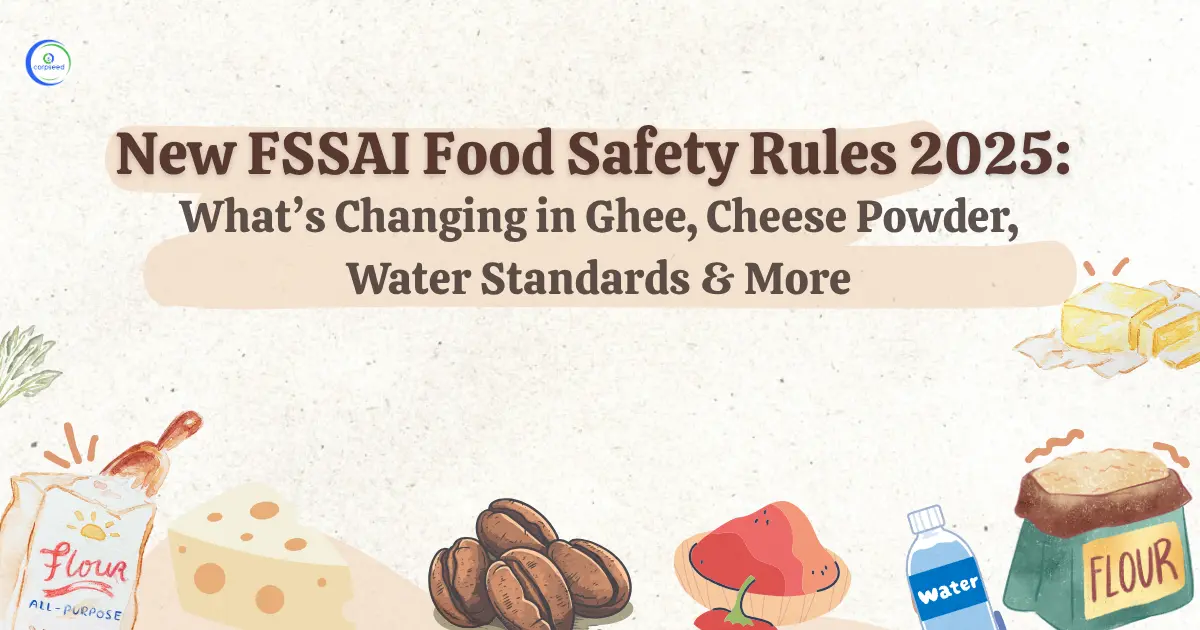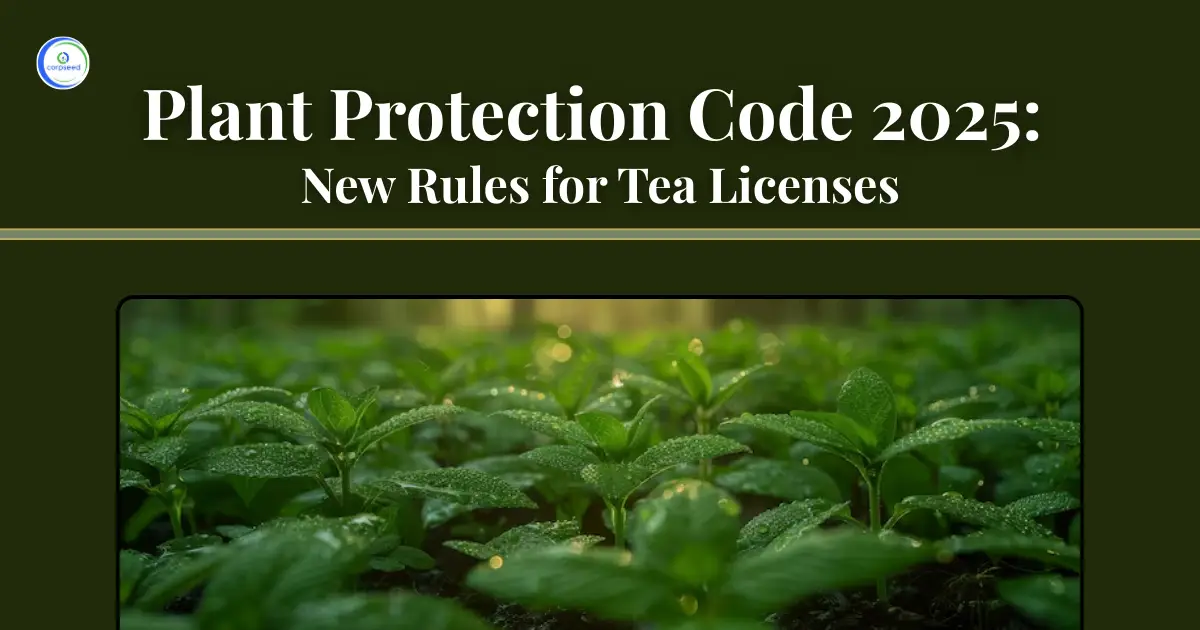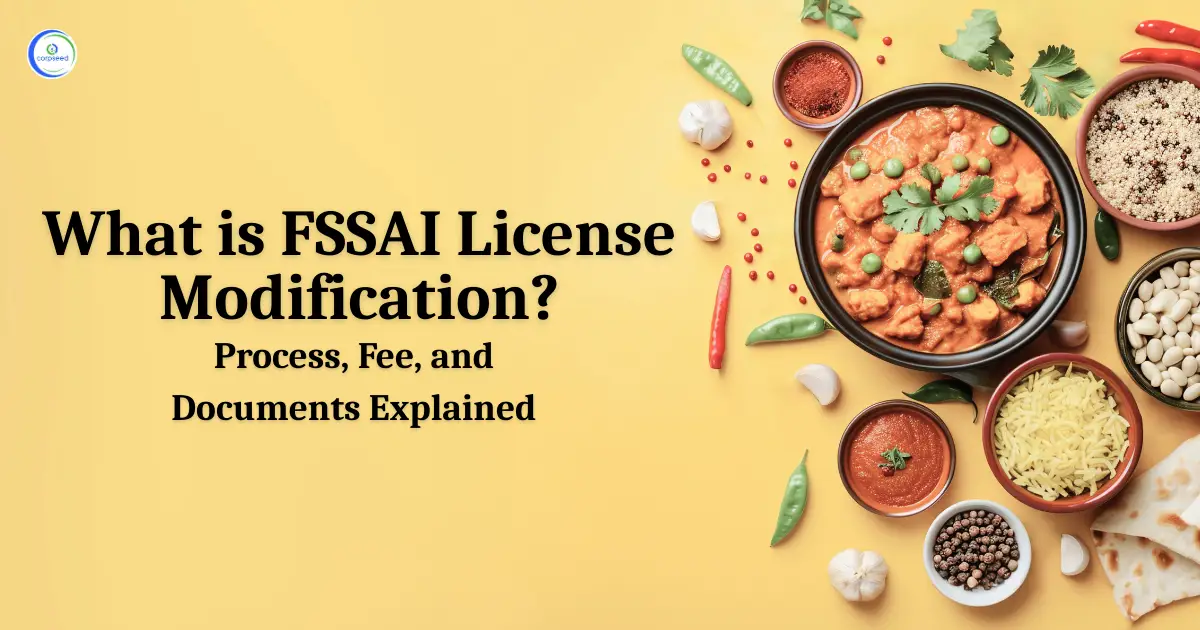The Food Safety and Standards Authority of India (FSSAI) has issued a draft notification proposing amendments to the Food Safety and Standards (Food Products Standards and Food Additives) Regulations, 2011. Published with the prior approval of the Central Government, the draft falls within the ambit of clause (e) of sub-section (2) of Section 92 read with Section 16 of the Food Safety and Standards Act, 2006. The public and all stakeholders have 60 days from the date of publication of the Gazette to submit their objections or suggestions. Once finalized, this amendment will impose changes in various categories of food products, affecting formulation, composition, labeling, and safety requirements.
Table of Contents
- Key Highlights of the FSSAI Draft Amendment Regulations, 2025
- Ghee Composition Updated
- New Standards for Cheese Powder
- Additional Provisions
- Change in Definition of “Animal”
- Revision in Caffeinated Beverage Regulations
- New Norms for Purified Drinking Water
- Additive Restrictions Extended to More Flours
- Additives for Sauce and Gravy Mixes Expanded
- Public Consultation Period
- Conclusion
Key Highlights of the FSSAI Draft Amendment Regulations, 2025
The Food Safety and Standards Authority of India (FSSAI) plans to update multiple food safety standards under the 2011 regulations. These updates will primarily impact product composition, labeling requirements, quality parameters, and FSSAI registration processes for food businesses. Following are the key changes that stakeholders and the public should know:
- Ghee Composition Updated: Revised fatty acid limits have been specified to better align with current quality expectations.
- New Standards for Cheese Powder: Cheese powder has been defined with specific composition, manufacturing, hygiene, and labelling requirements.
- Change in Definition of ‘Animal’: The term no longer includes “fish,” narrowing its scope under food standards.
- Revision in Caffeinated Beverage Regulations: Certain clauses under caffeinated beverage standards have been removed to simplify the regulation.
- Update in Beverage Standards: Specific entries related to other beverages and additives have been omitted or revised to reflect improved safety guidelines.
- New Norms for Purified Drinking Water: The regulation now clearly defines the quality requirements for purified drinking water in terms of clarity, composition, and purity.
- Additive Restrictions Extended to More Flours: The prohibition on additives is now extended to rice flour, millet flour, and mixed millet flour, in addition to Atta.
- Additives for Sauce and Gravy Mixes Expanded: More food additives have been permitted in ready-to-cook or processed sauce and gravy mixes.
--------------Blog Contact Form-------------
Ghee Composition Updated
Rule 2.1.8 of the 2011 regulations, which highlights the ‘Fatty Acid Composition of Ghee’, has been amended. The allowable ranges for two specific fatty acids have been updated to reflect better analytical standards and international standards. The revised entries relate to:
| “C16:0 Hexadecanoic acid (Palmitic acid) | 22.0-39.0 |
| C18:3 (cis 9,12,15) 9,12,15-Octadecatrienoic acid | 0.2-1.5” |
New Standards for Cheese Powder
A new sub-regulation 2.1.17(a) has been introduced to define and regulate ‘Cheese Powder’, a product gaining prominence in the food processing and snack industry.
- Description: Cheese powder is produced by drying cheese or a cheese slurry dispersed in potable water. It should be white, white with a greenish tinge, or light cream in appearance. The product must be free from hard lumps (except those that easily break) and scorched particles. No non-milk ingredients may be used, unless explicitly permitted.
- Cheese Slurry: Cheese slurry is obtained by grinding or blending cheese curd, and may include water, milk, cream, butter oil, and/or milk solids. It is ripened over a 2–3 week period to develop flavour, aided by modified starter cultures, adjunct cultures, and approved enzymes.
- Composition and Raw Materials: The permitted raw materials include cheese and cheese slurry. The only approved ingredients for use are sodium chloride and potable water.
| S. No. | Parameters | Requirements |
| 1 | Milk fat, Minimum, % (m/m), dry matter basi | 40.0 |
| 2 | Moisture, Maximum, %(m/m) | 5.0 |
| 3 | Salt (added sodium chloride), Maximum % (m/m) | 5.5 |
Additional Provisions
- Only food additives listed in ‘Appendix A’ may be used within the prescribed limits.
- The product must comply with the Contaminants, Toxins and Residues Regulations, 2011.
- All hygiene and handling practices must conform to ‘Schedule 4’ of the Licensing and Registration Regulations.
- Microbiological standards must match those in ‘Appendix B’.
- Labelling must follow the Food Safety and Standards (Labelling and Display) Regulations, 2020.
- Sampling and testing must align with methods FSSAI basic registration.
Change in Definition of “Animal”
In regulation 2.5.1, clause (a), the definition of “animal” has been modified. The phrase “and fish” has been removed, thereby excluding fish from the scope of “animal” in this context.
This change may impact how food products containing fish are categorised or regulated, especially with respect to labelling and food processing definitions.
Revision in Caffeinated Beverage Regulations
Under sub-regulation 2.10.6, clause (2), item III, sub-item (B) has been omitted. This section previously applied to caffeinated beverages, and its removal indicates a streamlining of existing provisions.
This amendment appears to reduce regulatory complexity for manufacturers of energy drinks and other caffeine-containing products.
New Norms for Purified Drinking Water
Regulation 2.10.9 has been comprehensively revised. Clause (2) now outlines the essential criteria for drinking water (purified), which must:
- Be clear and free from sediments, suspended particles, and extraneous matter.
- Comply with the physicochemical and safety standards detailed in six separate tables.
Table 1: Organoleptic and Physical Parameters
| S. No. | Characteristic | Permissible Limit |
| 1 | Colour, Hazen units, Max | 5 |
| 2 | Odour | Agreeable |
| 3 | pH value | 6.5-8.5 |
| 4 | Taste | Agreeable |
| 5 | Turbidity, NTU, Max | 1 |
| 6 | Total dissolved solids, mg/l, Max | 500 |
Table 2: General Parameters Concerning Substances Undesirable in Excessive Amounts
| S. No. | Characteristic | Permissible Limit |
| 1 | Aluminium (as Al), mg/l, Max | 0.03 |
| 2 | Ammonia (as total ammonia-N) mg/l, Max | 0.5 |
| 3 | Anionic detergents (as MBAS) mg/l, Max | 0.2 |
| 4 | Barium (as Ba), mg/l, Max | 0.7 |
| 5 | Boron (as B), mg/l, Max | 0.5 |
| 6 | Calcium (as Ca), mg/l, Max | 75 |
| 7 | Chloramines (as Cl2 ), mg/l, Max | 4.0 |
| 8 | Chloride (as Cl), mg/l, Max | 250 |
| 9 | Copper (as Cu), mg/l, Max | 0.05 |
| 10 | Fluoride (as F) mg/l, Max | 1.0 |
| 11 | Free residual chlorine, mg/l, Min | 0.2 |
| 12 | Iron (as Fe), mg/l, Max | 1.0 |
| 13 | Magnesium (as Mg), mg/l, Max | 30 |
| 14 | Manganese (as Mn), mg/l, Max | 0.1 |
| 15 | Mineral oil, mg/l, Max | 1.0 |
| 16 | Nitrate (as NO3 ), mg/l, Max | 45 |
| 17 | Phenolic compounds (as C6 H5OH), mg/l, Max | 0.001 |
| 18 | Selenium (as Se), mg/l, Max | 0.01 |
| 19 | Silver (as Ag), mg/l, Max | 0.1 |
| 20 | Sulphate (as SO4 ) mg/l, Max | 200 |
| 21 | Sulphide (as H2S), mg/l, Max | 0.05 |
| 22 | Total alkalinity as calcium carbonate, mg/l, Max | 200 |
| 23 | Total hardness (as CaCO3), mg/l, Max | 200 |
| 24 | Zinc (as Zn), mg/l, Max | 5 |
Table 3: Parameters Concerning Toxic Substances
| S. No. | Characteristic | Permissible Limit |
| 1 | Cadmium (as Cd), mg/l, Max | 0.003 |
| 2 | Cyanide (as CN), mg/l, Max | 0.05 |
| 3 | Lead (as Pb), mg/l, Max | 0.01 |
| 4 | Lead (as Pb), mg/l, Max | 0.001 |
| 5 | Molybdenum (as Mo), mg/l, Max | 0.07 |
| 6 | Nickel (as Ni), mg/l, Max | 0.02 |
| 7 | Polychlorinated biphenyls, mg/l, Max | 0.0005 |
| 8 | Polynuclear aromatic hydrocarbons (as PAH), mg/l, Max | 0.0001 |
| 9 | Total arsenic (as As), mg/l, Max | 0.01 |
| 10 | Total chromium (as Cr), mg/l, Max | 0.05 |
| 11 | Trihalomethanes: | |
| a) Bromoform, mg/l, Max | 0.1 | |
| b) Dibromochloromethane, mg/l, Max | 0.1 | |
| c) Bromodichloromethane mg/l, Max | 0.06 | |
| d) Chloroform, mg/l, Max | 0.2 |
Table 4: Parameters concerning radio-active residues
| S. No. | Characteristic | Permissible Limit |
| 1 | Alpha emitters Bq/l, Max | 0.1 |
| 2 | Beta emitters Bq/l, Max | 1.0 |
| 3 | Uranium, mg/l, Max | 0.03 |
Table 5: Microbiological Requirements
| S. No. | Characteristic | Permissible Limit |
| 1 | E. coli or thermotolerant coliform bacteria | Shall not be detectable in any 100 ml sample |
| 2 | Total coliform bacteria | Shall not be detectable in any 100 ml sample |
Table 6: Parameters concerning pesticide residues
| S. No. | Characteristic | Permissible Limit |
| 1 | Alachlor | 20 |
| 2 | Atrazine | 2 |
| 3 | Aldrin/Dieldrin | 0.03 |
| 4 | Alpha HCH | 0.01 |
| 5 | Beta HCH | 0.04 |
| 6 | Butachlor | 125 |
| 7 | Chlorpyriphos | 30 |
| 8 | Delta HCH | 0.04 |
| 9 | 2,4- Dichlorophenoxyacetic acid | 30 |
| 10 | DDT (o, p and p, p – Isomers of DDT DDE and DDD) | 1 |
| 11 | Endosulfan (alpha, beta, and sulphate) | 0.4 |
| 12 | Ethion | 3 |
| 13 | Gamma — HCH (Lindane) | 2 |
| 14 | Isoproturon | 9 |
| 15 | Malathion | 190 |
| 16 | Methyl parathion | 0.3 |
| 17 | Monocrotophos | 1 |
| 18 | Phorate | 2 |
Additive Restrictions Extended to More Flours
Under Appendix A, Table 6, the additive restriction previously limited to "Atta" has been expanded. The updated note reads:
“No additives permitted in Atta, Rice flour (including the flour for Fortified Rice Kernel preparation), Millet flour, and mixed millet flour”
This amendment reinforces FSSAI’s clean label initiative for staple grain products.
Additives for Sauce and Gravy Mixes Expanded
In Appendix A, Table 12, under Food Category System 12.6.3 (Mixes for sauces and gravies), new additives have been added following the entry for sodium alum inosilicate.
These additions aim to provide greater flexibility to manufacturers while maintaining food safety.
Table 12: New additives and limits
| Food Category System | Food Category Name | Food Additive | INS No | Recommended Maximum Level | Note |
| “12.6.3 | Mixes for sauces and gravies | Sucrose esters of fatty acids | 473 | 10,000 mg/kg | 127” |
Also Read: FSSAI's New Guidelines for Recycled PET in Food Contact Materials
Public Consultation Period
The draft regulations are currently open for public consultation. Objections or suggestions may be submitted to the FSSAI within 60 days from the date the Gazette notification is made available to the public.
Conclusion
The Food Safety and Standards (Food Products Standards and Food Additives) Amendment Regulations, 2025, mark another progressive step by FSSAI toward food safety standards with developing industrial practices, consumer protection and global standards. From introducing standards for cheese powder to improving water quality requirements and clarifying food additive restrictions, these amendments validate a thorough and science-based approach to food regulation.
Stakeholders are advised to review the amendments carefully, predominantly in light of potential implications for product formulation, labelling, compliance protocols, and market access. Timely feedback and industry engagement will be essential in shaping a safe, transparent, and sustainable food safety ecosystem in India.
This portion of the site is for informational purposes only. The content is not legal advice. The statements and opinions are the expression of author, not corpseed, and have not been evaluated by corpseed for accuracy, completeness, or changes in the law.
BOOK A FREE CONSULTATION
Get help from an experienced legal adviser. Schedule your consultation at a time that works for you and it's absolutely FREE.









